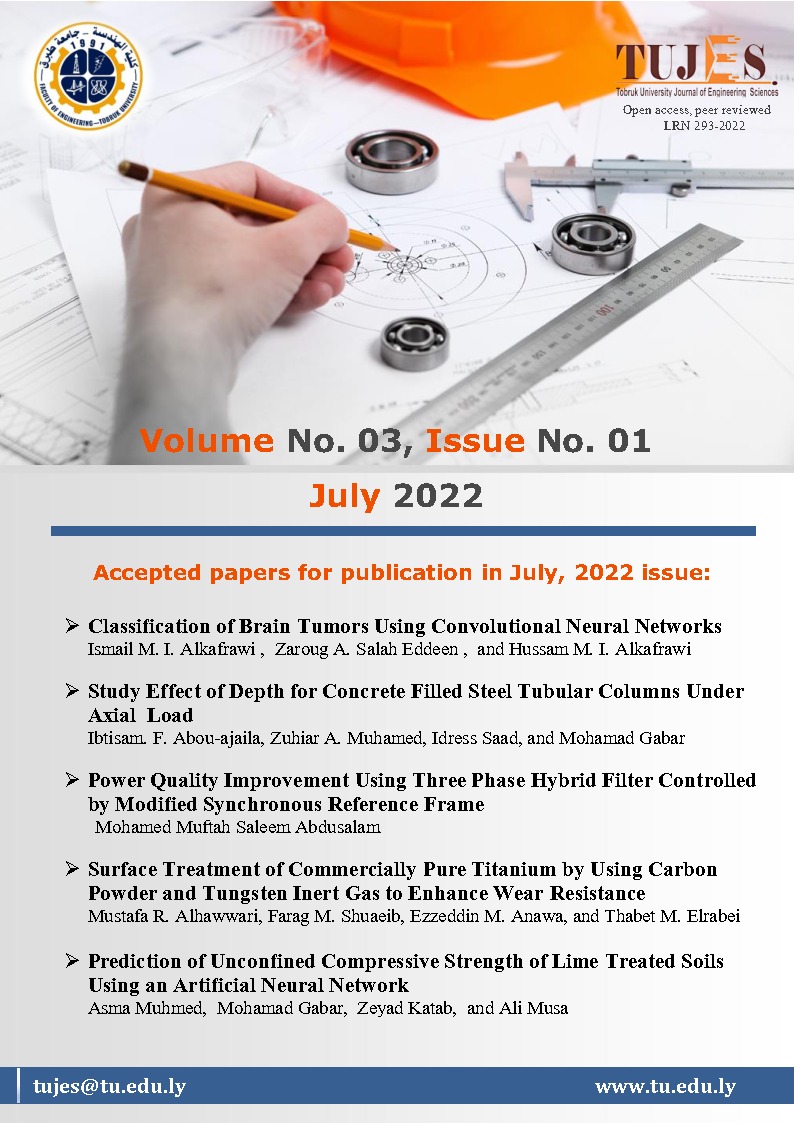Study Effect of Depth for Concrete Filled Steel Tubular Columns under Axial Load
DOI:
https://doi.org/10.64516/wd7dnt90Keywords:
Concrete-filled steel tube (CFT), ANSYS, Finite element method (FEM)Abstract
The main purpose of this research is to study the effect of length on the CFT columns analytical using the finite element FE method. ANSYS software is employed to evaluate the CFT columns behavior. 3-D finite element models are presented and calibrated successfully to predict the CFT columns performance under axial static loading. A parametric study was conducted to evaluate the performance of CFT columns that examines the effect of all the dimensions of the CFT columns on the columns performance. The study considers varying the geometrical of the CFT columns, such as column width-to-thickness ratio and column length-to-width. The test results showed that increasing the slenderness ratio L/B has a negligible effect on the load capacity of the column but is accompanied by a large reduction of its ductility.
References
1. Goode. D. C., Kuranovas. A., and Kvedaras. K. A. (2010). (Buckling of slender composite concrete filled steel
columns). Journal of Civil Engineering and Management, Vol. 16, No. 2, pp. 230-236. Received 30 Oct. 2009;
Accepted 11Feb. 2010.
2. Johansson, M. (2002). (Composite action and confinement effects in tubular steel-concrete columns). Licentiate thesis, Chalmers University of Technology, Department of Structural Engineering Sweden.
3. Neogi, p. k., Sen, H. K., and Chaprnan, J. C. (1969). (Concrete filled tubular steel columns under eccentric loading). The Structural Engineering, Vol. 47, No. 5, May 1969, pp. 187-195.
4. Chen, W. F., and Chen C. H. (1973). (Analysis of concrete-filled steel tubular beam-columns). IABSE Publications, Vol. 33, No. II, pp. 37-52.
5. Bridge, R. Q. (1976). (Concrete filled steel tubular columns). Civil Engineering Transactions, the Institution of Engineers, Australia, CE18 (2), pp. 127-133.
6. Prion, H. G. L., and Boehme, J. (1989). (Beam-column behavior of steel tubes filled with high strength concrete). Proceedings of the Fourth International Colloquium, Structural Stability Research Council, New York, pp.439-450.
7. Knowles, R. B., and park, R. (1969). (Strength of concrete filled steel tubular columns). Journal of the Structural Division, ASCE, Vol. 95, No. 12, pp. 2565-2587.
8. Architectural Institute of Japan (AIJ) (1997). (Recommendations for design and construction of concrete filled steel tubular structures). Tokyo, Japan.
9. Ibrahim, M. S. (2006). (Behavior of box steel columns filled with concrete under cyclic loading). Thesis No. 4149 library Alexandria University, Egypt.
10. Shakir Khalil, H. (1991). (Tests on concrete-filled hollow section columns). Proceedings of the Third International Conference on Steel-Concrete Composite Structures, Wakabayashi, M. (ed.)m Fukuoka, Japan, September 26-29, 1991, Association for International Cooperation and Research in Steel-Concrete Composite Structures, pp. 89-94.
11. O’Shea, M., and Bridge R. (1996). (Circular thin-walled tubes with high strength concrete infill). Composite Construction in Steel and Concrete II, ASCE, pp. 780–793.
12. O’Shea, M., and Bridge R. (1997). (The design for local buckling of concrete filled steel tubes). Composite Construction Conventional and Innovate, Innsbruck, Austria, pp. 319–324.
13. Eurocode 4, ENV 1994-1-1: 2004. Design of composite steel and concrete structures. Part 1.1: General rules and rules for buildings. London; 1994.
14. Shakir Khalil, H., and Zeghiche, Z. (1989). (Experimental behavior of concrete filled rolled rectangular hollow-section columns). The Structural Engineering, Vol. 67, No. 19, pp.345-353.
15. Tsuda, K., Matsui, C., and Mino, E. (1996). (Strength and behavior of slender concrete filled steel tubular columns). Stability Problems in Designing, Construction and Rehabilitation of Metal Structures, Proccedings of the Fifth International Colloquium on Structural Stability, SSRC IC/BRASIL ’96, Rio de Janerio, Brasil, August 5-7, Structural Stability Research Council, Bethlehem, Pennsylvania, pp. 489-500.
16. ANSYS 10.0 complete user’s manual set. Downloaded from http://www1.ansys.com/customer/content/documentation/100/ansys/readme.htm1.
17. Hu, H. T., Huang, C. S., Wu, M. H., and Wu, Y. M. (2002). (Numerical analysis of concrete-filled steel tubes subjected to axial force). Proceedings of the International Workshop on Steel and Concrete Composite Construction, National Center for Research on Earthquake Engineering, National Taiwan University, China.
18. Hu, H. T., Huang, C. S., Wu, M. H., and Wu, Y. M. (2003). (Nonlinear analysis of axially loaded concrete-filled tube columns with confinement effect). Journal of Structural Engineering, ASCE, Vol. 129, No. 10, pp. 1322-1329.
19. Dalin Liu. (2005). (Behavior of eccentrically loaded high strength rectangular concrete filled steel tubular columns). Journal of Constructional Steel Research, 2006 Vol. 62, PP. 839-846.
20. American Concrete Institute (ACI) (2002). (Building code requirements for structural concrete and commentary). ACI 318-02, Detroit.
21. Rabie. A. Amnisi, Ibtisam. F. ABOU-AJAILA and Maryam. E. Darwish. (2022). (Comparison Between Analytical and Experimental Methods for Concrete Filled Steel Tubular Columns), Albahit journal of applied sciences ISSN2708=244X, e=ISSN 2708-8936, Vol.3, Issue 1, pp. 41- 48.
22. Ge, H. B., and Usami, T. (1996). (Cyclic tests of concrete-filled steel box columns), Journal of Structural Engineering, Vol. 122, No. 10, pp. 1169–1177.
23. Farag, E. S., Elhwiety, M. M., Abo Elfath, H., and Mashaly, E. (2012). (Performance of concrete filled partially steel slender columns under axial load). M. SC. Thesis. Alexandria University, Structural Engineering Department, Egypt.
Downloads
Published
Issue
Section
License
Copyright (c) 2022 Ibtisam. F. Abou-ajaila, Zuhiar A. Muhamed, Idress Saad, Mohamad Gabar (Author)

This work is licensed under a Creative Commons Attribution 4.0 International License.













